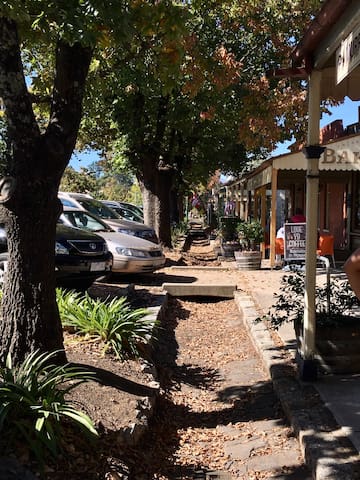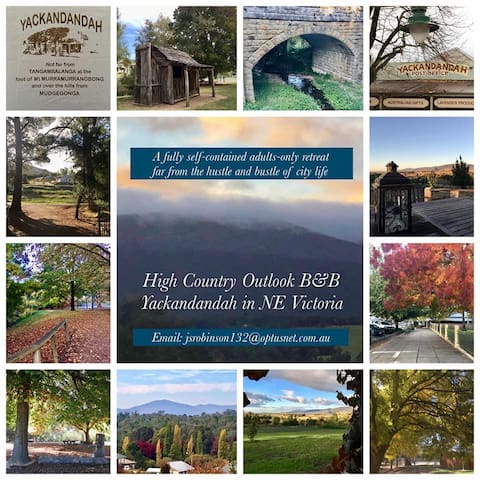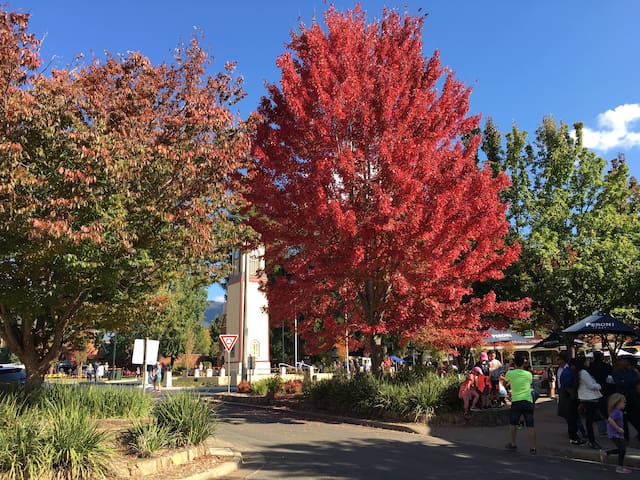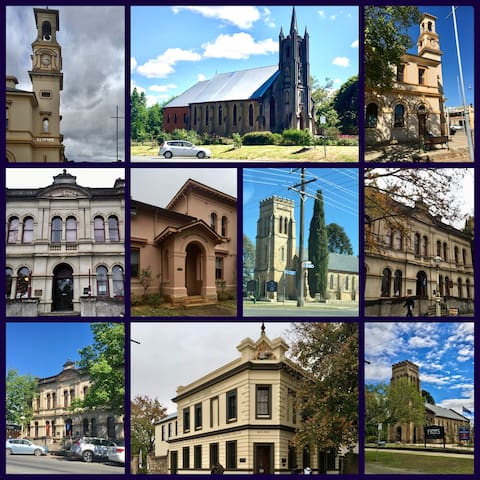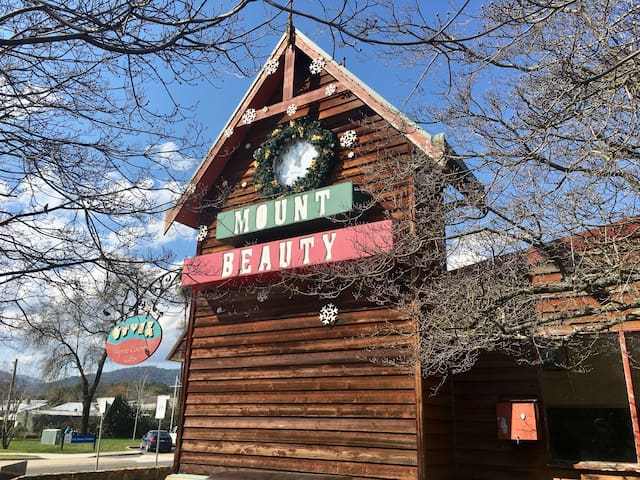City/town information
High Country Outlook B&B is situated less than a kilometre from Yackandandah’s High Street. Your temporary home-away-from-home is nestled on the outskirts of a picturesque historic village situated in a valley amidst a series of rolling hills. The streetscape is largely unchanged from its heyday as a goldmining town. Many of Yack’s buildings are genuinely historic and the entire commercial area has been classified by the National Trust. The main street is lined with shady English trees (some planted in the 19th century), quaint verandas, wide awnings, tea houses, galleries, shops selling crafts, gifts, antiques and collectables, and a couple of country pubs, while several gracious old churches can be found on the side streets.
With a population of around 900, Yackandandah is located 288 km north-east of Melbourne via Beechworth and 28 km south-west of Wodonga. Fishing, gold-panning, gemstone fossicking, mountain-biking, cycling the historic rail trails, horse-riding, bushwalking and four-wheel driving are all popular in the surrounding countryside.
Yackandandah is also central to many interesting towns around the region that offer a host of wine varieties, gourmet food choices and entertainment activities to interested travellers. So, come and see what’s on offer here during your stay.
28 lokal ang nagrerekomenda
Yackandandah
High Country Outlook B&B is situated less than a kilometre from Yackandandah’s High Street. Your temporary home-away-from-home is nestled on the outskirts of a picturesque historic village situated in a valley amidst a series of rolling hills. The streetscape is largely unchanged from its heyday as a goldmining town. Many of Yack’s buildings are genuinely historic and the entire commercial area has been classified by the National Trust. The main street is lined with shady English trees (some planted in the 19th century), quaint verandas, wide awnings, tea houses, galleries, shops selling crafts, gifts, antiques and collectables, and a couple of country pubs, while several gracious old churches can be found on the side streets.
With a population of around 900, Yackandandah is located 288 km north-east of Melbourne via Beechworth and 28 km south-west of Wodonga. Fishing, gold-panning, gemstone fossicking, mountain-biking, cycling the historic rail trails, horse-riding, bushwalking and four-wheel driving are all popular in the surrounding countryside.
Yackandandah is also central to many interesting towns around the region that offer a host of wine varieties, gourmet food choices and entertainment activities to interested travellers. So, come and see what’s on offer here during your stay.
Sightseeing
A Bit of History and Moving Forward in Time: Yackandandah and the Valley of Gold offer many attractions to visitors, the main one being its wonderful ambience. This gorgeous town oozes character all year round. A cold day in Yack calls for hot soup around a friendly log fire at one of the hotels, or when summertime comes, locals and visitors alike enjoy sitting on the veranda or alfresco area of its cafes watching life go by.
Explorers Hamilton Hume and William Hovell passed through the area in 1824, although the first settlers didn’t arrive until 1837. Pastoralist David Reid discovered gold in 1845 when excavating the water-race for a flour mill. Word soon got around, and suddenly the great Victorian gold rush was on in earnest, with prospectors swarming throughout the North-East and panning almost every stream for gold. Yack was also home to Sir Isaac Isaacs, the first Australian-born Governor General. In 1864, he was the first pupil to be registered at the Yackandandah Primary School.
Renowned as one of Australia's prettiest villages with a centre classified by the national trust, Yackandandah is nestled in the foothills of Stanley State Forest and steeped in the legacy of gold. Today the town is home to many acclaimed artists, from potters to painters, sculptors to stitchers – and a few authors. Wander the stunning streets of Yack to discover unique artworks, crafts, music and antiques in the eclectic mix of galleries, shops and studios.
Yackandandah's entire commercial centre has been classified by the National Trust and features many well-preserved buildings which date back to the mid and late 1800s during the height of the town's gold mining days. Highlights include the Athenaeum (built in 1878), the Court House (1863) which is now used as a community hall, the Bank of Victoria building (1860) which now houses Yack’s Museum, and the old Post Office (first built as a timber structure in 1856) where the local Visitor Information Centre is located.
Commissioners Creek runs through Yackandandah and features a number of attractions, including a replica miner’s hut close by the skatepark, a mineral spring accessed via Mineral Lane, and several parks and recreational facilities near Williams Street.
An interesting drive can be enjoyed along Bells Flat Road at the bottom of our street. At Crossing Place, a walking track leads to The Gorge, which is a man-made diversion of Yackandandah Creek that allowed miners to search for gold along the original creek bed. Bells Flat Road also passes through old gold mining areas featuring shafts and diggings. Access is either by car or a walkway leading to the gorge commencing just over the bridge at the bottom of our street.
A short drive north-east of Yackandandah is the small community of Allans Flat, located in a rich agricultural area which is home to wineries and a strawberry farm. Allans Flat Reserve is a large lake which was originally created by gold dredging and is now a scenic spot for swimming and canoeing.
Take some time out to enjoy our pretty home town’s relaxed pace, the fruits of a vibrant and active community and an emerging events calendar.
28 lokal ang nagrerekomenda
Yackandandah
A Bit of History and Moving Forward in Time: Yackandandah and the Valley of Gold offer many attractions to visitors, the main one being its wonderful ambience. This gorgeous town oozes character all year round. A cold day in Yack calls for hot soup around a friendly log fire at one of the hotels, or when summertime comes, locals and visitors alike enjoy sitting on the veranda or alfresco area of its cafes watching life go by.
Explorers Hamilton Hume and William Hovell passed through the area in 1824, although the first settlers didn’t arrive until 1837. Pastoralist David Reid discovered gold in 1845 when excavating the water-race for a flour mill. Word soon got around, and suddenly the great Victorian gold rush was on in earnest, with prospectors swarming throughout the North-East and panning almost every stream for gold. Yack was also home to Sir Isaac Isaacs, the first Australian-born Governor General. In 1864, he was the first pupil to be registered at the Yackandandah Primary School.
Renowned as one of Australia's prettiest villages with a centre classified by the national trust, Yackandandah is nestled in the foothills of Stanley State Forest and steeped in the legacy of gold. Today the town is home to many acclaimed artists, from potters to painters, sculptors to stitchers – and a few authors. Wander the stunning streets of Yack to discover unique artworks, crafts, music and antiques in the eclectic mix of galleries, shops and studios.
Yackandandah's entire commercial centre has been classified by the National Trust and features many well-preserved buildings which date back to the mid and late 1800s during the height of the town's gold mining days. Highlights include the Athenaeum (built in 1878), the Court House (1863) which is now used as a community hall, the Bank of Victoria building (1860) which now houses Yack’s Museum, and the old Post Office (first built as a timber structure in 1856) where the local Visitor Information Centre is located.
Commissioners Creek runs through Yackandandah and features a number of attractions, including a replica miner’s hut close by the skatepark, a mineral spring accessed via Mineral Lane, and several parks and recreational facilities near Williams Street.
An interesting drive can be enjoyed along Bells Flat Road at the bottom of our street. At Crossing Place, a walking track leads to The Gorge, which is a man-made diversion of Yackandandah Creek that allowed miners to search for gold along the original creek bed. Bells Flat Road also passes through old gold mining areas featuring shafts and diggings. Access is either by car or a walkway leading to the gorge commencing just over the bridge at the bottom of our street.
A short drive north-east of Yackandandah is the small community of Allans Flat, located in a rich agricultural area which is home to wineries and a strawberry farm. Allans Flat Reserve is a large lake which was originally created by gold dredging and is now a scenic spot for swimming and canoeing.
Take some time out to enjoy our pretty home town’s relaxed pace, the fruits of a vibrant and active community and an emerging events calendar.
BRIGHT – the township, not something vivid or shiny! – is situated on the scenic Great Alpine Road between Porepunkah and Harrietville in the beautiful Ovens Valley. The town is a popular tourist centre due to its close proximity to the mountain and ski resorts of Mount Buffalo, Mount Hotham and Falls Creek, along with other natural attractions such as the Alpine National Park and Mount Buffalo National Park.
A number of attractive parks and reserves are located within Bright and two popular ones stretch along the Ovens River. Both feature attractive picnic spots and grassy areas which extended right down to the river. There is a water slide, aquatic play area and a designated swimming hole at the junction of the Ovens River and Morses Creek, accessible via a footbridge.
Bright is particularly eye-catching and popular during autumn, when the blazing colours of its large variety of deciduous trees create a spectacular display, celebrated annually by the Bright Autumn Festival. Good spots to appreciate the town’s vibrant autumn colours include along Delany Avenue where burning red leaves of oak intermingle with the dark green of cedar trees. Cobden Street, near Ireland Street, is also most colourful in autumn, as are Howitt Park and Centenary Park. Oh, and don’t forget to drop into the all-year Christmas shop in Barnard Street with so many gorgeous decorations & festive items. Open seven days a week, except for Christmas Day, with hours Mon to Sat from 10.00 a.m. to 5.00 p.m. and Sundays from 10.00 a.m. to 4.00 p.m.
65 lokal ang nagrerekomenda
Bright
BRIGHT – the township, not something vivid or shiny! – is situated on the scenic Great Alpine Road between Porepunkah and Harrietville in the beautiful Ovens Valley. The town is a popular tourist centre due to its close proximity to the mountain and ski resorts of Mount Buffalo, Mount Hotham and Falls Creek, along with other natural attractions such as the Alpine National Park and Mount Buffalo National Park.
A number of attractive parks and reserves are located within Bright and two popular ones stretch along the Ovens River. Both feature attractive picnic spots and grassy areas which extended right down to the river. There is a water slide, aquatic play area and a designated swimming hole at the junction of the Ovens River and Morses Creek, accessible via a footbridge.
Bright is particularly eye-catching and popular during autumn, when the blazing colours of its large variety of deciduous trees create a spectacular display, celebrated annually by the Bright Autumn Festival. Good spots to appreciate the town’s vibrant autumn colours include along Delany Avenue where burning red leaves of oak intermingle with the dark green of cedar trees. Cobden Street, near Ireland Street, is also most colourful in autumn, as are Howitt Park and Centenary Park. Oh, and don’t forget to drop into the all-year Christmas shop in Barnard Street with so many gorgeous decorations & festive items. Open seven days a week, except for Christmas Day, with hours Mon to Sat from 10.00 a.m. to 5.00 p.m. and Sundays from 10.00 a.m. to 4.00 p.m.
BEECHWORTH, located only 20 kms away, is a little gem and one of Victoria's best-preserved former gold mining towns boasting several buildings dating back to the 19th Century. The Historic and Cultural Precinct is a major attraction offering insights into life on the early goldfields with the town's old court house, telegraph station, town hall, and museum. Most notable in the historic precinct is the Old Beechworth Gaol, built between 1859 and 1864. A dark cell was once the unwelcome home of the infamous bushranger Ned Kelly, and this is now open to the public for tours or to pick up a bushranger-themed souvenir.
Beechworth is known for its attractive streets and parks lined with deciduous trees, which paint an intense colourful display in autumn. Its main shopping precinct offers visitors several streets housing quaint shops, including the local honey shop and Beechworth gold outlets, along with lots of other speciality traders, restaurants and cafés – one of our favourite eateries is a small cafe located at the top end of Ford Street heading towards Wangaratta, just down from the historic Christ Church Anglican Parish with its eye-catching stone tower. This delightful café/gift shop offers baked potatoes with a vast assortment of toppings and flavours, along with several other meal choices, beverages and sweet treats.
For keen walkers and cyclists, the Murray to Mountains Rail Trail passes through the town. For a scenic drive close to the town centre, follow the one-way 5km Gorge Road route, which begins at the junction of Sydney road at the Golden Horseshoe Monument. This sealed road then runs along the edge of the Beechworth Historic Park with a network of walking trails, geological features and relics of the region's gold mining history including a powder magazine built in 1859. Scenic views towards the Beechworth township and countryside to the west can be enjoyed at a couple of large granite outcrops along the route. The bridge where Gorge Road crosses Spring Creek offers an interesting view of this lovely waterway as it cascades downhill along a rocky bed. Gorge Road ends at the Newtown Falls near Ford Street. A viewing platform provides good views of the falls and Newtown Bridge, which was constructed from granite in 1874.
81 lokal ang nagrerekomenda
Beechworth
BEECHWORTH, located only 20 kms away, is a little gem and one of Victoria's best-preserved former gold mining towns boasting several buildings dating back to the 19th Century. The Historic and Cultural Precinct is a major attraction offering insights into life on the early goldfields with the town's old court house, telegraph station, town hall, and museum. Most notable in the historic precinct is the Old Beechworth Gaol, built between 1859 and 1864. A dark cell was once the unwelcome home of the infamous bushranger Ned Kelly, and this is now open to the public for tours or to pick up a bushranger-themed souvenir.
Beechworth is known for its attractive streets and parks lined with deciduous trees, which paint an intense colourful display in autumn. Its main shopping precinct offers visitors several streets housing quaint shops, including the local honey shop and Beechworth gold outlets, along with lots of other speciality traders, restaurants and cafés – one of our favourite eateries is a small cafe located at the top end of Ford Street heading towards Wangaratta, just down from the historic Christ Church Anglican Parish with its eye-catching stone tower. This delightful café/gift shop offers baked potatoes with a vast assortment of toppings and flavours, along with several other meal choices, beverages and sweet treats.
For keen walkers and cyclists, the Murray to Mountains Rail Trail passes through the town. For a scenic drive close to the town centre, follow the one-way 5km Gorge Road route, which begins at the junction of Sydney road at the Golden Horseshoe Monument. This sealed road then runs along the edge of the Beechworth Historic Park with a network of walking trails, geological features and relics of the region's gold mining history including a powder magazine built in 1859. Scenic views towards the Beechworth township and countryside to the west can be enjoyed at a couple of large granite outcrops along the route. The bridge where Gorge Road crosses Spring Creek offers an interesting view of this lovely waterway as it cascades downhill along a rocky bed. Gorge Road ends at the Newtown Falls near Ford Street. A viewing platform provides good views of the falls and Newtown Bridge, which was constructed from granite in 1874.
MOUNT BEAUTY is located at the southern end of the picturesque Kiewa Valley and at the base of Victoria’s highest mountain, Mount Bogong. It is located 31 kilometres west of the popular holiday town of Bright and is separated from the small community of Tawonga South by the babbling Kiewa River.
There are two primary access routes into Mount Beauty. The route south along the Kiewa Valley Highway from Wodonga roughly follows the path of the Kiewa River through a rich and fertile valley, offering a number of scenic viewing points, including the Mount Bogong Lookout, just south of Tawonga. Alternatively, access via the Tawonga Road from Bright allows travellers to cross from the Ovens Valley to the Kiewa Valley and enjoy stunning lookouts along the way at Tawonga Gap and Sullivans Lookout. N.B. See our recommendation for a day trip through this picturesque area in the B&B's full compendium.
Mount Beauty was originally established in the 1940s as a base for workers on the Kiewa Hydro-Electric Scheme. Since then it has developed into a popular tourist town, located 30 kilometres from the major ski resort of Falls Creek and a scenic drive away from Alpine attractions such as Mount Buffalo and Mount Hotham.
As the name suggests, Mount Beauty is a place of significant natural beauty. It is surrounded by the Alpine National Park which features lakes, forests and snowfields, offering visitors scenic backdrops wherever in town they happen to be. The town's commercial centre features several attractive parks and an interesting selection of speciality shops along the shady Hollonds Street and Kiewa Crescent.
The Mount Beauty Pondage, which is a popular recreational facility for watersports, is surrounded by a walking track, several parks and picnic areas. The Alpine Discovery Centre, located just west of the town centre, gives an educational and entertaining insight into the development of the upper Kiewa Valley.
The scenic drive out of town on the Bogong High Plains Road, on the way to Falls Creek, passes through some interesting attractions such as the Clover Hydro-Electric Power Station, a waterfall at Slippery Rock Creek, and Bogong Village which has been built into the steep mountainside. The entrance gates to Falls Creek are located at Howmans Gap (fee payable during snow season), and from there the road passes through the Falls Creek Alpine Resort, linking up with the Omeo Highway north of Omeo. N.B. the route through to Omeo is closed during snow season.
24 lokal ang nagrerekomenda
Mount Beauty
MOUNT BEAUTY is located at the southern end of the picturesque Kiewa Valley and at the base of Victoria’s highest mountain, Mount Bogong. It is located 31 kilometres west of the popular holiday town of Bright and is separated from the small community of Tawonga South by the babbling Kiewa River.
There are two primary access routes into Mount Beauty. The route south along the Kiewa Valley Highway from Wodonga roughly follows the path of the Kiewa River through a rich and fertile valley, offering a number of scenic viewing points, including the Mount Bogong Lookout, just south of Tawonga. Alternatively, access via the Tawonga Road from Bright allows travellers to cross from the Ovens Valley to the Kiewa Valley and enjoy stunning lookouts along the way at Tawonga Gap and Sullivans Lookout. N.B. See our recommendation for a day trip through this picturesque area in the B&B's full compendium.
Mount Beauty was originally established in the 1940s as a base for workers on the Kiewa Hydro-Electric Scheme. Since then it has developed into a popular tourist town, located 30 kilometres from the major ski resort of Falls Creek and a scenic drive away from Alpine attractions such as Mount Buffalo and Mount Hotham.
As the name suggests, Mount Beauty is a place of significant natural beauty. It is surrounded by the Alpine National Park which features lakes, forests and snowfields, offering visitors scenic backdrops wherever in town they happen to be. The town's commercial centre features several attractive parks and an interesting selection of speciality shops along the shady Hollonds Street and Kiewa Crescent.
The Mount Beauty Pondage, which is a popular recreational facility for watersports, is surrounded by a walking track, several parks and picnic areas. The Alpine Discovery Centre, located just west of the town centre, gives an educational and entertaining insight into the development of the upper Kiewa Valley.
The scenic drive out of town on the Bogong High Plains Road, on the way to Falls Creek, passes through some interesting attractions such as the Clover Hydro-Electric Power Station, a waterfall at Slippery Rock Creek, and Bogong Village which has been built into the steep mountainside. The entrance gates to Falls Creek are located at Howmans Gap (fee payable during snow season), and from there the road passes through the Falls Creek Alpine Resort, linking up with the Omeo Highway north of Omeo. N.B. the route through to Omeo is closed during snow season.

